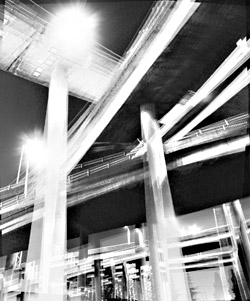The state recently announced that it has increased its list of viaduct replacement options from three to 10. But with the removal of the old, unstable structure still four years off, some might wonder: What if an earthquake were to hit in the meantime?
After all, it was the 2001 Nisqually earthquake that set the viaduct sinking into Elliott Bay, and since then a group of earthsciences and urban-planning experts at the University of Washington have repeatedly warned the state to shut down the elevated roadway as soon as possible. If an earthquake were to strike at rush hour tomorrow, and a collapsed viaduct killed thousands, would the state end up paying damages on wrongful death lawsuits?
Many states employ “sovereign immunity” to protect themselves from litigation, while others cap the damages governments can pay. For example, Minnesota, the state with the most recent highway collapse, doesn’t have sovereign immunity but does cap damages at $1 million per incident. (Bridge victims there are being compensated through a $38 million fund set up by the state legislature.) Washington waived sovereign immunity in 1961 (Attorney General Rob McKenna’s recent efforts to curtail the state’s liability have failed) and places no cap on damages. So in theory, hypothetical plaintiffs could go ahead with their suits and demand a lot of money. But successfully suing the state would still be a tricky prospect.
“If it were a huge earthquake and even new buildings were collapsing, it would be a lot harder to say that the state was negligent with the viaduct,” says Chuck Paglialunga, whose law firm, Paglialunga and Harris, handles cases involving wrongful deaths and negligent highway design. “On the other hand, if it were a mild earthquake and the viaduct still collapsed, that might show it was unreasonably dangerous.”
But the size of the earthquake would be just the first issue. Were there affordable interim measures the state could have taken to lessen the risk? It’s already spending nearly $15 million on emergency repairs; designing and implementing a replacement structure or system will be vastly more expensive. (Of course, the UW experts who called for the viaduct’s closure noted that a planned interruption is less costly than an emergent one. It may also be worth considering that the costs of steel and cement are expected to continue to rise as China’s economy grows.)
However, even if the math favored the plaintiffs—that is, if the probability of a disaster multiplied by the cost of damages exceeded the cost of repairs—the state could probably invoke “discretionary immunity.” This court-created doctrine holds that high-level discretionary acts by the government—basically, decisions of policy direction, as opposed to implementation—are immune from lawsuits.
Still, there might be one last angle. “Here’s the kicker,” says Louis Wolcher, a professor of torts at the UW School of Law. “There are two different kinds of theories a plaintiff can assert. One is, you should have designed it better, retrofitted it, or shut it down. The other is that you should have provided adequate warning.” Wolcher notes that the state might argue that local drivers were aware of the risks, and admits he’s at a loss as to what such warning signs might say. Nevertheless, perhaps the state will want to add this 11th interim option to its list.







